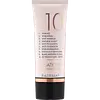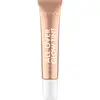What's inside
What's inside
 Key Ingredients
Key Ingredients

 Benefits
Benefits

 Concerns
Concerns

 Ingredients Side-by-side
Ingredients Side-by-side

Water
Skin ConditioningDimethicone
EmollientPolysilicone-11
Glycerin
HumectantEthylhexyl Methoxycinnamate
UV AbsorberNiacinamide
SmoothingButylene Glycol
HumectantMica
Cosmetic ColorantButyl Methoxydibenzoylmethane
UV AbsorberOctocrylene
UV AbsorberSynthetic Fluorphlogopite
Bis-Ethylhexyloxyphenol Methoxyphenyl Triazine
Skin ConditioningTocopheryl Acetate
AntioxidantPolyacrylamide
C13-14 Isoparaffin
EmollientIsohexadecane
EmollientPPG-26-Buteth-26
Skin ConditioningPolyglyceryl-4 Isostearate
EmulsifyingZingiber Officinale Root Extract
MaskingCetyl PEG/PPG-10/1 Dimethicone
EmulsifyingPEG-40 Hydrogenated Castor Oil
EmulsifyingAmmonium Polyacryloyldimethyl Taurate
Emulsion StabilisingHexyl Laurate
EmollientEthylhexylglycerin
Skin ConditioningDisodium EDTA
Laureth-7
EmulsifyingLaureth-12
EmulsifyingPolysorbate 80
EmulsifyingBHT
AntioxidantPolysorbate 20
EmulsifyingTin Oxide
AbrasivePhenoxyethanol
PreservativeParfum
MaskingCitronellol
PerfumingLinalool
PerfumingLimonene
PerfumingCitral
PerfumingCI 77491
Cosmetic ColorantCI 77492
Cosmetic ColorantCI 77499
Cosmetic ColorantCI 77891
Cosmetic ColorantWater, Dimethicone, Polysilicone-11, Glycerin, Ethylhexyl Methoxycinnamate, Niacinamide, Butylene Glycol, Mica, Butyl Methoxydibenzoylmethane, Octocrylene, Synthetic Fluorphlogopite, Bis-Ethylhexyloxyphenol Methoxyphenyl Triazine, Tocopheryl Acetate, Polyacrylamide, C13-14 Isoparaffin, Isohexadecane, PPG-26-Buteth-26, Polyglyceryl-4 Isostearate, Zingiber Officinale Root Extract, Cetyl PEG/PPG-10/1 Dimethicone, PEG-40 Hydrogenated Castor Oil, Ammonium Polyacryloyldimethyl Taurate, Hexyl Laurate, Ethylhexylglycerin, Disodium EDTA, Laureth-7, Laureth-12, Polysorbate 80, BHT, Polysorbate 20, Tin Oxide, Phenoxyethanol, Parfum, Citronellol, Linalool, Limonene, Citral, CI 77491, CI 77492, CI 77499, CI 77891
Water
Skin ConditioningSynthetic Fluorphlogopite
Mica
Cosmetic ColorantSqualane
EmollientPropanediol
SolventGlycerin
HumectantAmmonium Acryloyldimethyltaurate/Vp Copolymer
Sodium Ascorbyl Phosphate
AntioxidantPanthenol
Skin ConditioningNiacinamide
SmoothingGlyceryl Rosinate
PerfumingSilica
AbrasiveXanthan Gum
EmulsifyingEthylhexylglycerin
Skin ConditioningSodium Phytate
Cellulose
AbsorbentSodium Sulfate
Lactic Acid
BufferingCitric Acid
BufferingPhenoxyethanol
PreservativeTin Oxide
AbrasiveCI 77491
Cosmetic ColorantCI 77891
Cosmetic ColorantWater, Synthetic Fluorphlogopite, Mica, Squalane, Propanediol, Glycerin, Ammonium Acryloyldimethyltaurate/Vp Copolymer, Sodium Ascorbyl Phosphate, Panthenol, Niacinamide, Glyceryl Rosinate, Silica, Xanthan Gum, Ethylhexylglycerin, Sodium Phytate, Cellulose, Sodium Sulfate, Lactic Acid, Citric Acid, Phenoxyethanol, Tin Oxide, CI 77491, CI 77891
 Reviews
Reviews

Ingredients Explained
These ingredients are found in both products.
Ingredients higher up in an ingredient list are typically present in a larger amount.
Ci 77491 is also hydrated iron III oxide. It's sole purpose is to give a red/pink hue to products.
Iron III oxides are classified as inorganic chemicals for coloring.
Synthetically created Ci 77491 is considered safer than those naturally found. This is because the synthetically created version may contain less impurities. Iron oxides are generally non-toxic and non-allergenic.
Learn more about CI 77491Ci 77891 is a white pigment from Titanium dioxide. It is naturally found in minerals such as rutile and ilmenite.
It's main function is to add a white color to cosmetics. It can also be mixed with other colors to create different shades.
Ci 77891 is commonly found in sunscreens due to its ability to block UV rays.
Learn more about CI 77891Ethylhexylglycerin (we can't pronounce this either) is commonly used as a preservative and skin softener. It is derived from glyceryl.
You might see Ethylhexylglycerin often paired with other preservatives such as phenoxyethanol. Ethylhexylglycerin has been found to increase the effectiveness of these other preservatives.
Glycerin is already naturally found in your skin. It helps moisturize and protect your skin.
A study from 2016 found glycerin to be more effective as a humectant than AHAs and hyaluronic acid.
As a humectant, it helps the skin stay hydrated by pulling moisture to your skin. The low molecular weight of glycerin allows it to pull moisture into the deeper layers of your skin.
Hydrated skin improves your skin barrier; Your skin barrier helps protect against irritants and bacteria.
Glycerin has also been found to have antimicrobial and antiviral properties. Due to these properties, glycerin is often used in wound and burn treatments.
In cosmetics, glycerin is usually derived from plants such as soybean or palm. However, it can also be sourced from animals, such as tallow or animal fat.
This ingredient is organic, colorless, odorless, and non-toxic.
Glycerin is the name for this ingredient in American English. British English uses Glycerol/Glycerine.
Learn more about GlycerinMica is a naturally occurring mineral used to add shimmer and color in cosmetics. It can also help improve the texture of a product or give it an opaque, white/silver color.
Serecite is the name for very fine but ragged grains of mica.
This ingredient is often coated with metal oxides like titanium dioxide. Trace amounts of heavy metals may be found in mica, but these metals are not harmful in our personal products.
Mica has been used since prehistoric times throughout the world. Ancient Egyptian, Indian, Greek, Roman, Aztec, and Chinese civilizations have used mica.
Learn more about MicaNiacinamide is a multitasking form of vitamin B3 that strengthens the skin barrier, reduces pores and dark spots, regulates oil, and improves signs of aging.
And the best part? It's gentle and well-tolerated by most skin types, including sensitive and reactive skin.
You might have heard of "niacin flush", or the reddening of skin that causes itchiness. Niacinamide has not been found to cause this.
In very rare cases, some individuals may not be able to tolerate niacinamide at all or experience an allergic reaction to it.
If you are experiencing flaking, irritation, and dryness with this ingredient, be sure to double check all your products as this ingredient can be found in all categories of skincare.
When incorporating niacinamide into your routine, look out for concentration amounts. Typically, 5% niacinamide provides benefits such as fading dark spots. However, if you have sensitive skin, it is better to begin with a smaller concentration.
When you apply niacinamide to your skin, your body converts it into nicotinamide adenine dinucleotide (NAD). NAD is an essential coenzyme that is already found in your cells as "fuel" and powers countless biological processes.
In your skin, NAD helps repair cell damage, produce new healthy cells, support collagen production, strengthen the skin barrier, and fight environmental stressors (like UV and pollution).
Our natural NAD levels start to decline with age, leading to slower skin repair, visible aging, and a weaker skin barrier. By providing your skin niacinamide, you're recharging your skin's NAD levels. This leads to stronger, healthier, and younger looking skin.
Another name for vitamin B3 is nicotinamide. This vitamin is water-soluble and our bodies don't store it. We obtain Vitamin B3 from either food or skincare. Meat, fish, wheat, yeast, and leafy greens contain vitamin B3.
The type of niacinamide used in skincare is synthetically created.
Learn more about NiacinamidePhenoxyethanol is a preservative that has germicide, antimicrobial, and aromatic properties. Studies show that phenoxyethanol can prevent microbial growth. By itself, it has a scent that is similar to that of a rose.
It's often used in formulations along with Caprylyl Glycol to preserve the shelf life of products.
Synthetic Fluorphlogopite is the synthethic version of mica. It consists of fluorine, aluminum and silicate.
Synthetic Fluorphlogopite is used to add volume to products.
It is considered non-irritating on the skin.
Learn more about Synthetic FluorphlogopiteTin Oxide is an inorganic oxide used to add opacity and volume to a product. In nature, it is already found in mineral form. The main ore of tin is an opaque and shiny mineral called casseterite.
Tin Oxide helps remove translucency in a product, or make it more opaque. Besides adding opacity, tin oxide is used for bulking to add volume.
Water. It's the most common cosmetic ingredient of all. You'll usually see it at the top of ingredient lists, meaning that it makes up the largest part of the product.
So why is it so popular? Water most often acts as a solvent - this means that it helps dissolve other ingredients into the formulation.
You'll also recognize water as that liquid we all need to stay alive. If you see this, drink a glass of water. Stay hydrated!
Learn more about Water